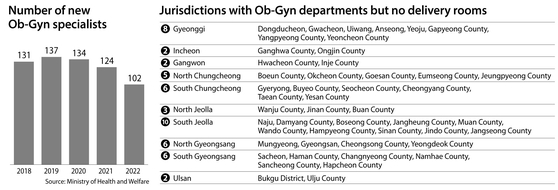As birthrates plummet, a serious Ob-Gyn shortage looms
![A room for newborns at a hospital in Seoul, unrelated to the story. [YONHAP]](https://koreajoongangdaily.joins.com/data/photo/2023/10/09/155209c1-60db-4361-8fdd-dfdd763f9709.jpg)
A room for newborns at a hospital in Seoul, unrelated to the story. [YONHAP]
Korea today has the lowest fertility rate in the world.
The fertility rate, or the number of children a woman gives birth to during her childbearing years, has continued to drop since falling below one for the first time in 2018.
Last year, the total fertility rate hit a record low of 0.78 percent.
The rate had further dropped to 0.7 percent as of the second quarter.
On Sept. 30, Munhwa Woman Hospital in Gwangju had to close after helping women give birth for 25 years.
The hospital had eight specialists, including five Ob-Gyn physicians.
On Sept. 1, Fraumedi Hospital, which has been delivering babies in Ulsan for 33 years, suspended operations indefinitely.
Last year alone, the Ob-Gyn hospital delivered 37 percent of newborns in Ulsan.
The hospital cited a lack of staff for its indefinite suspension.
According to Statistics Korea and the Health and Welfare Ministry, 512 medical institutions delivered babies as of 2020.
By 2022, that figure dropped roughly 9 percent to 470 institutions.
Compared to 2012, when 739 institutions delivered babies, the number was down 36.4 percent.
Areas outside of Seoul and the greater Seoul area have been hit the hardest.
There are 50 cities, counties and districts where hospitals have Ob-Gyn departments but no delivery room.
This means that pregnant women in these regions must go somewhere else to give birth.
Even finding a physician specializing in deliveries is difficult.
New Ob-Gyn physicians have dropped from 134 in 2020 to 102 last year.
To make matters worse, most new Ob-Gyn physicians specialize in gynecology, including cancer treatment.
Medical workers say many physicians avoid the field because it harms their personal lives.
Physicians are on constant call as childbirths could come at any time, and emergencies are always possible.
Moreover, as the number of Ob-Gyn physicians shrinks, those who remain must endure more and more shifts.
Additionally, as more women prefer physicians of their own sex to assist with their deliveries, the number of men joining the field plummeted from 91 in 2007 to seven in 2023.
"Currently, even at the big five hospitals, three to four doctors in their 50s and 60s are taking turns on 24-hour standby," said a hospital employee who requested anonymity. "What kind of young physician would want to work under such circumstances?"
The employee added that many women doctors — though not all — dislike delivery room duty and its many emergency situations.
"The number of men Ob-Gyn physicians should be increased, considering the deployment of public health doctors in remote areas," they said.

Some 79 percent of the respondents cited worries over medical accidents during childbirth.
"Even when I was a medical student in the 1990s, many fellow students preferred not to major in Ob-Gyn because doctors have to pay a lot in malpractice compared to what they make for delivering babies," said a doctor who requested anonymity.
Park Joong-shin, chairman of the Korean Society of Obstetrics and Gynecology and also an Ob-Gyn professor at Seoul National University Hospital, also cited lawsuits.
"Young physicians avoid Ob-Gyn in part because of the malpractice suits that occur after accidents during childbirth," Park said. "The government needs to increase its share of compensating families so that doctors won't be sued personally."
Doctors warn that the Ob-Gyn situation is entering a vicious cycle, with the number of hospitals shrinking due to fewer and fewer newborns, which in turn discourages couples from having children, forcing hospitals to contract still further.
"The collapse of childbirth infrastructure is not only happening outside of the greater Seoul area but even in Seoul and Gyeonggi," said Oh Soo-young, an Ob-Gyn professor at Sungkyunkwan University School of Medicine.
"The number of pregnant women at high risk is increasing because they are giving birth at an older age," Oh said. "The government has to work on measures, including the improvement of medical fees."
BY YI WOO-LIM, LEE HO-JEONG [lee.hojeong@joongang.co.kr]










with the Korea JoongAng Daily
To write comments, please log in to one of the accounts.
Standards Board Policy (0/250자)